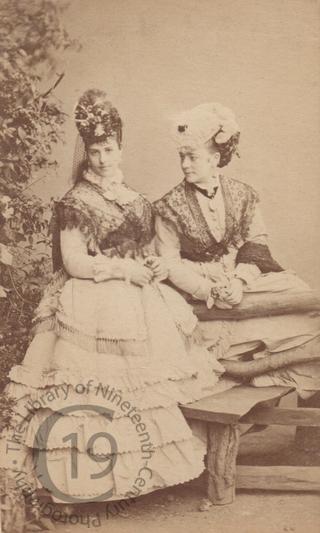
Mabel Grey and Kate Cooke
A carte-de-visite portrait of the notorious courtesans Mabel Grey (on the left) and Kate Cooke (on the right).
According to Barry Anthony’s Murder, Mayhem and Music Hall: The Dark Side of Victorian London (2015), Kate Cooke was born into poverty in or about 1842 and became ‘an equestrian performer in her teens, living for a time with a circus showman called Cooke. Tiring of his abusive behaviour, she married a commercial traveller, George Manby Smith, in Glasgow in July 1863, only to be deserted by him after five months. The following year she arrived in London where she stayed at a brothel run by a Mrs White, in Sutherland Street, Pimlico. Within a few hours she had become indebted to Mrs Rosalie Bernstein, a widow who supplied the six women in the house with fashionable clothing to be paid for in instalments or by grateful customers. […] There was soon no shortage of admirers to escort Kate to nightspots such as the Argyle Rooms, Cremorne and the Holborn Casino.’
Eventually Kate fell out with her supplier Mrs Bernstein, now Mrs Ochse since her marriage in 1866 to Prussian milliner Charles Ochse. The latter was forced to resort to the courts in an attempt to recover £665 he and his wife were owed for various items of finery they had provided for Kate. Newspaper readers were regaled with shocking details of Kate Cooke’s life, her expensive parasols, her lace-trimmed underwear and other ‘extravagant articles which could only be wanted by a person of [the] defendant’s calling.’ Since it soon became apparent that the Ochses were well aware of how Kate earned her living, Mr Justice Blackburn ruled that ‘if articles were furnished for the purpose of enabling a woman to carry on her avocation of a prostitute, the law would not assist the person furnishing the goods. […] The jury at once returned a verdict for the defendant’ (Cork Examiner, 28 January 1870).
The following year, on 29 May 1871 at St Michael’s Church, Worcester, Kate, using the name Kate Walsh Smith and claiming she was a widow, married the Honourable Henry James Fitzroy, the eldest son and heir of Lord Augustus Charles Lennox Fitzroy. Kate's father-in-law became the 7th Duke of Grafton on the death of his brother in 1882. At this point, Kate’s husband assumed the courtesy title Earl of Euston. His marriage had produced no children and the couple had separated after three years. Lord Euston had secured a government position in Australia in 1875 and had remained there until 1881. On returning to England and making enquiries, he had learnt that his marriage had been bigamous, at least on Kate’s part, and in 1884 he sought a declaration of nullity. At great expense Kate’s putative husband, George Manby Smith, was located in New Zealand and brought to London to give evidence. It transpired, however, that when he had married Kate in Glasgow in 1863, he was already a married man, with a wife who was still very much alive, though she had since died of cancer in 1867. His marriage to Kate was therefore invalid, which meant that hers to Lord Euston was perfectly legal (Flintshire Observer Mining Journal, 10 April 1884).
Kate remained the Countess of Euston until her death, which took place in Fulham on 24 November 1903.
Photographed by Hills and Saunders of London.
Code: 127438




